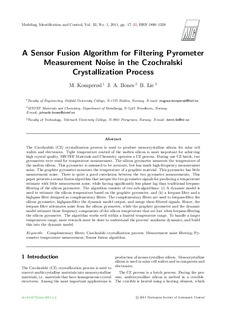| dc.contributor.author | Komperød, Magnus | |
| dc.contributor.author | Bones, John Atle | |
| dc.contributor.author | Lie, Bernt | |
| dc.date.accessioned | 2011-12-30T09:35:41Z | |
| dc.date.accessioned | 2017-04-19T12:49:40Z | |
| dc.date.available | 2011-12-30T09:35:41Z | |
| dc.date.available | 2017-04-19T12:49:40Z | |
| dc.date.issued | 2011 | |
| dc.identifier.citation | Modeling, Identification and Control 32(2011) Nr.1, S.39-46. | |
| dc.identifier.issn | 1890-1328 | |
| dc.identifier.uri | http://hdl.handle.net/11250/2438388 | |
| dc.description.abstract | The Czochralski (CZ) crystallization process is used to produce monocrystalline silicon for solar cell wafers and electronics. Tight temperature control of the molten silicon is most important for achieving high crystal quality. SINTEF Materials and Chemistry operates a CZ process. During one CZ batch, two pyrometers were used for temperature measurement. The silicon pyrometer measures the temperature of the molten silicon. This pyrometer is assumed to be accurate, but has much high-frequency measurement noise. The graphite pyrometer measures the temperature of a graphite material. This pyrometer has little measurement noise. There is quite a good correlation between the two pyrometer measurements. This paper presents a sensor fusion algorithm that merges the two pyrometer signals for producing a temperature estimate with little measurement noise, while having signi cantly less phase lag than traditional lowpass- ltering of the silicon pyrometer. The algorithm consists of two sub-algorithms: (i) A dynamic model is used to estimate the silicon temperature based on the graphite pyrometer, and (ii) a lowpass lter and a highpass lter designed as complementary lters. The complementary lters are used to lowpass- lter the silicon pyrometer, highpass- lter the dynamic model output, and merge these ltered signals. Hence, the lowpass lter attenuates noise from the silicon pyrometer, while the graphite pyrometer and the dynamic model estimate those frequency components of the silicon temperature that are lost when lowpass- ltering the silicon pyrometer. The algorithm works well within a limited temperature range. To handle a larger temperature range, more research must be done to understand the process' nonlinear dynamics, and build this into the dynamic model. | |
| dc.language.iso | nob | |
| dc.subject | Complementary filters | |
| dc.subject | Czochralski crystallization process | |
| dc.subject | Measurement noise filtering | |
| dc.subject | Pyrometer temperature measurement | |
| dc.subject | Sensor fusion algorithm | |
| dc.title | A Sensor Fusion Algorithm for Filtering Pyrometer Measurement Noise in the Czochralski Crystallization Process | |
| dc.type | Journal article | |
| dc.type | Peer reviewed | |
| dc.description.version | Published version | |
| dc.subject.nsi | 429 | |
| dc.identifier.doi | http://dx.doi.org/10.4173/mic.2011.1.2 | |
